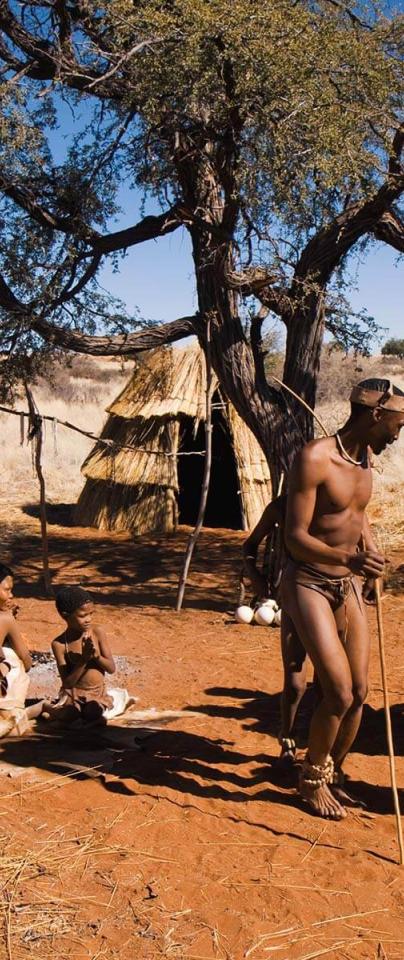Of Mice and Men: life at the limits
How are mice so adaptable to extreme environments? We speak to EI Fellow David Thybert about the hardy desert mouse.
For many of us mere humans at Earlham Institute, even withstanding temperatures above 25 degrees is a formidable task. Not so for desert mice, which can tolerate extreme environments and temperatures up to 42 degrees Celsius - taking it all in their tiny stride.
David Thybert, research Fellow at EI, has focused his work on understanding how rodents are able to withstand incredibly extreme arid environments such as deserts - and thrive in situations that are completely inhospitable for most forms of life, let alone mammals.
The tricks to their tolerance can, as is so often the case, be found nested within their uniquely-attuned genomes - and can also provide hints to the basis of human conditions such as obesity and diabetes.

Deserts are some of the most inhospitable environments on Earth, but many animals here thrive.
Deserts are pretty inhospitable places. Even plants struggle to get a stranglehold in such environments - and the life that does exist in these arid places is sparse compared to more lush, rainy regions such as rainforests and grasslands.
Still, life finds a way, and among the hardy beasts that call the desert home are several species of rodent, which are very well adapted to tolerate the challenges that accompany life under the baking hot sun.
It’s of no real surprise that such organisms have come to colonise arid, or xeric, environments (those lacking moisture), as they form the Earth’s largest terrestrial ecosystem - covering almost one third of the world’s land mass.
In terms of studying how organisms can adapt to extreme conditions, rodents present an interesting model organism due to their diversity in terms of species and variety of phenotypes even in closely related species - but also because of their alternative methods of withstanding hardship.
One model, for example, is the Algerian mouse, Mus spretus, which colonises much of North Africa and the Iberian Peninsula and is very much related to the European house mouse.
As a nocturnal animal, the Algerian mouse comes out at night to avoid the warmer temperatures of a Mediterranean summer, and can drink two-thirds less water and can stand higher temperature than the domestic mouse, which goes some way to helping it survive in a semi-arid environment.
To understand how the Algerian mouse became more adapted to arid condition, David is sampling DNA from wild Mus spretus living in the oceanic region of north-west of Portugal and Almeria in the south-east of Spain, which is a semi-desertic climate. This DNA will be used to sequence and compare the genome of different individuals from the two areas to identify the regions of the genome that change to adapt to the desert.
Hardier still, are the highly specialised spiny mice of the Acomys genus, two very closely related species of which have actually adopted different routines that probably helps them to avoid too much competition.
The nocturnal Cairo spiny mouse, Acomys cahirinus, shares a similar habitat with the diurnal golden spiny mouse Acomys russatus. A. cahirinus tends to prefer less arid environments, while A. russatus can tolerate extremely arid conditions; though the two often share the same habitat - when they do, the diurnal behaviour of A. russatus allows them to avoid food competition with A. cahirinus which is faster and therefore poses a threat to their food supply.

Deserts, including polar deserts, cover almost a third of the Earth's surface.
A. russatus is of particular interest to the study of adaptation. For one, it obtains most of its moisture from a plant that also thrives in the desert, while producing urine that is extremely concentrated in order that it doesn’t lose too much water - in fact, it can drink seawater and still maintain kidney function.
Of even greater interest to science, A. russatus can also stand temperatures of up to 42 degrees celsius, which is extremely high for a rodent. As such, this tiny mouse has a very low metabolic rate, which helps it to survive on a low food supply.
However, when it comes to living in captivity this can pose a health hazard - and A. russatus can suffer. At temperatures of below 18 degrees celsius, some mice will have difficulties to maintain their body temperature and can die , while others in captivity suffer from illness such as obesity and diabetes linked to low metabolism, which present a useful case study to inform important health issues in humans.
In the Western world, obesity and diabetes in particular appear to be associated with the rapid development of a lifestyle that evolution has struggled to keep up with. Therefore, looking at how these diseases present themselves in desert mice living under similarly altered conditions might inform us of how they are manifested in people, as well.
The interesting phenotypes of Acomys do not end here. They are able to regenerate tissues like skin and cartilage. This is the first recorded instance of this in any mammals, for that matter.
Science has never really before had a mammals model to study tissues regeneration, thus further study into these tiny spiny mice might may have important implication in regenerative medicine and help cure people seriously burned or harmed.
Mice are not from Mars, but like Earth and Mars, albeit from cells and nucleic acids rather than dust clouds, the Nannomys mice diverged from a common ancestor to house mice (Mus musculus) around three to six million years ago.
The Nannomys, also known as African pygmy mice, are a miniscule five grams and represent some of the smallest rodents on earth.
Two such rodents are of interest to study in terms of how species adapt to different environments. Mus indutus, the desert pygmy mouse, colonises the Kalahari desert - and as such is adapted to tolerate an extremely arid environment.
Another species, Mus minutoides, thrives in a grassland environment - and the two species diverged two million years ago may be sympatric i.e. they inhabit the same geographic region.
Such species are interesting to study in terms of direct comparison, as we can hope to find the specific genetic regions present in Mus indutus that helps them prosper in a more arid environment than their closely related cousins.


More than one billion people live in desert regions, despite us being poorly adapted, biologically, to this environment.

Another interesting feature of Mus minutoides is that it appears to undergo a reversal of sex determination, straying away from the classic XX/XY, which is extremely rare for a mammalian species. Indeed, there exists a high proportion of fertile females that present as XY rather than XX.
Indeed, in some populations a whopping 74% of female Mus minutoides are XY. It turns out that there is quite a diversity within the X chromosome of these pygmy mice, with morphologically different X chromosomes causing this sex reversal. As such a rare example within mammals, these mice therefore present an interesting case to study determination of sex in all mammalian species.
With over 1500 species, the rodent present the most diverse group of mammals to study. Considering their close evolutionary ties,they are especially interesting to study in terms of adaptation to different environments and niches.
Furthermore, with their suite of interesting phenotypes, including many directly relevant to diseases that present in humans, the study of rodents might help us to further dissect how our own bodies function and inform us of how to combat such emergent illnesses as diabetes and obesity, which are becoming ever-more present in the 21st Century.
“With their wide distribution all over the world and their diversity of phenotypes even between closely related species, rodents are ideal models to understand how mammals evolve and adapt to new environments,” said David Thybert. “Understanding the molecular mechanisms of rodent evolution and adaptation are crucial to better protect species threatened by global climate change and to better understand phenotypes associated to human disease.”
*Image at the top of the article provided by Frederic Veyrunes.